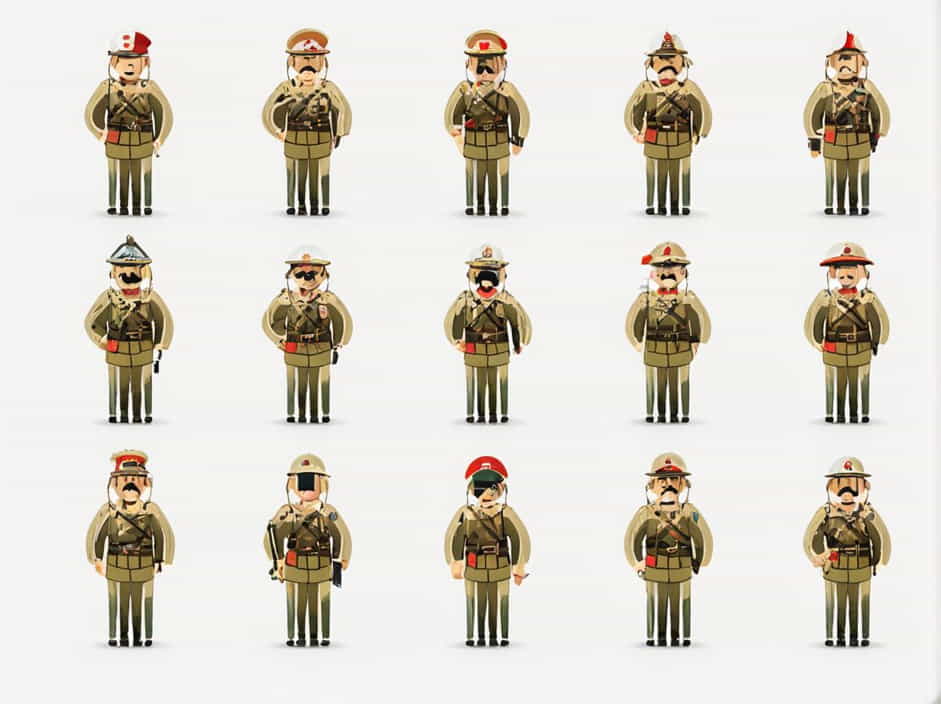The Austro-Hungarian Army (1867-1918) was one of the most complex military forces in Europe, reflecting the diverse cultures, ethnicities, and traditions of the Austro-Hungarian Empire. Its uniforms were equally diverse, combining traditional elements, national distinctions, and modernization efforts over time.
From the elaborate parade uniforms of the 19th century to the practical field uniforms of World War I, the attire of the Austro-Hungarian Army symbolized both imperial grandeur and military necessity. This topic explores the styles, colors, insignia, and evolution of these uniforms, offering a comprehensive look into the attire of one of history’s most fascinating military forces.
Early Uniforms of the Austro-Hungarian Army
1. The Influence of the Habsburg Empire (Before 1867)
Before the formation of Austria-Hungary in 1867, the Habsburg Monarchy maintained a well-organized military force. Soldiers wore uniforms inspired by Napoleonic-era styles, featuring:
- White coats with colored facings (lapels, collars, and cuffs) indicating regiment identity.
- Shakos and bicorne hats as standard headgear.
- Highly decorative epaulettes and gold braiding for officers.
These uniforms reflected the ceremonial elegance of the 18th and early 19th centuries but were less practical for combat.
2. The 1867 Compromise and Military Reorganization
After the Austro-Hungarian Compromise, the army was divided into three main forces:
- The Common Army (Gemeinsame Armee), serving both Austria and Hungary.
- The Austrian Landwehr, the territorial army of Austria.
- The Hungarian Honvéd, the territorial army of Hungary.
Each force had its own uniform distinctions, but the Common Army maintained a unified military appearance.
The Common Army Uniforms (1867-1914)
The standard uniform of the Common Army featured blue-gray tunics, a shift from the earlier white coats. Key elements included:
1. Headgear
- Pike Gray Kepi – A soft cap with a black leather peak, inspired by French military fashion.
- Shako – A tall, cylindrical hat used in formal occasions and parades.
- Steel Helmets (1916 Onwards) – The Austro-Hungarian Army adopted a version of the German Stahlhelm for trench warfare.
2. Tunics and Jackets
- M1867 Tunic – Blue-gray with a standing collar, worn with a belt.
- M1908 Field Tunic – A more practical design with simplified buttons and reinforced pockets.
3. Trousers and Footwear
- Pike Gray Trousers – Standard issue for all ranks.
- Leather Boots – Higher-ranking officers wore polished knee-high boots, while enlisted men had shorter boots with gaiters.
4. Insignia and Rank Distinctions
- Collar tabs and shoulder boards indicated regiment and rank.
- Hungarian regiments often had distinctive braiding and embroidery.
- Austrian Landwehr troops wore edelweiss insignia on their uniforms.
The Hungarian Honvéd and Austrian Landwehr Uniforms
1. The Hungarian Honvéd
The Hungarian Honvéd Army had a unique uniform reflecting Hungary’s national identity. Differences included:
- Dark blue or green tunics instead of standard pike gray.
- Traditional Hungarian-style braiding on the chest and cuffs.
- Distinctive kepis with Hungarian cockades.
Honvéd units were highly motivated and fiercely proud of their distinct uniforms, which reflected Hungary’s military heritage.
2. The Austrian Landwehr
The Austrian Landwehr, though similar to the Common Army, had slight modifications, such as:
- Edelweiss insignia worn on caps and tunics.
- Darker shades of blue-gray in their uniforms.
- More lightweight materials for mountain and alpine warfare.
These differences allowed for clear distinction between the regular army and territorial units.
Officer Uniforms and Decorations
1. Officer Tunics and Attire
Austro-Hungarian officers were known for their elegant uniforms, featuring:
- Gold or silver embroidery on collars and cuffs.
- Double-breasted coats for senior officers.
- Sabers and decorative belts worn during parades.
2. Medals and Awards
Officers displayed numerous decorations, such as:
- The Military Merit Cross (awarded for bravery).
- The Order of the Iron Crown (for distinguished service).
- Wound Badges (introduced during World War I).
Each medal signified the rank, achievements, and prestige of the soldier wearing it.
Field Uniforms During World War I (1914-1918)
1. The Shift to Practicality
At the outbreak of World War I, the Austro-Hungarian Army quickly realized that its bright-colored uniforms were impractical for modern warfare. This led to:
- The introduction of pike gray as the standard color for blending into the battlefield.
- A simplified tunic design with reinforced stitching for durability.
- The use of steel helmets (Stahlhelm) from 1916 onward.
2. Specialized Uniforms for Different Units
- Mountain Troops (Kaiserjà¤ger and Gebirgsjà¤ger) wore lightweight, insulated tunics for high-altitude conditions.
- Artillery and Cavalry units had longer coats for mobility.
- Medical personnel wore armbands with red crosses for identification.
By 1917, the Austro-Hungarian Army had fully transitioned to more practical wartime uniforms, resembling those of their German allies.
Legacy and Influence on Modern Uniforms
1. Influence on Post-War Militaries
After the fall of the Austro-Hungarian Empire in 1918, its uniforms influenced the militaries of Austria, Hungary, Czechoslovakia, and Yugoslavia.
- Austria’s First Republic Army retained pike gray uniforms.
- Hungary modified Honvéd designs for its interwar forces.
- Czechoslovakia adapted former Austro-Hungarian styles into its new army.
2. Collectability and Historical Significance
Today, Austro-Hungarian military uniforms are highly sought after by collectors and historians due to their unique blend of imperial and national influences. Museums around the world display these uniforms as a testament to the empire’s military and cultural heritage.
The uniforms of the Austro-Hungarian Army were a symbol of the empire’s rich diversity and military tradition. From the elegant pre-war designs to the practical field gear of World War I, each uniform reflected the challenges and evolution of the empire’s armed forces.
Although the Austro-Hungarian Empire no longer exists, its military uniforms remain an important part of European history, offering insight into imperial traditions, battlefield adaptations, and the legacy of one of Europe’s most powerful multi-ethnic armies.
